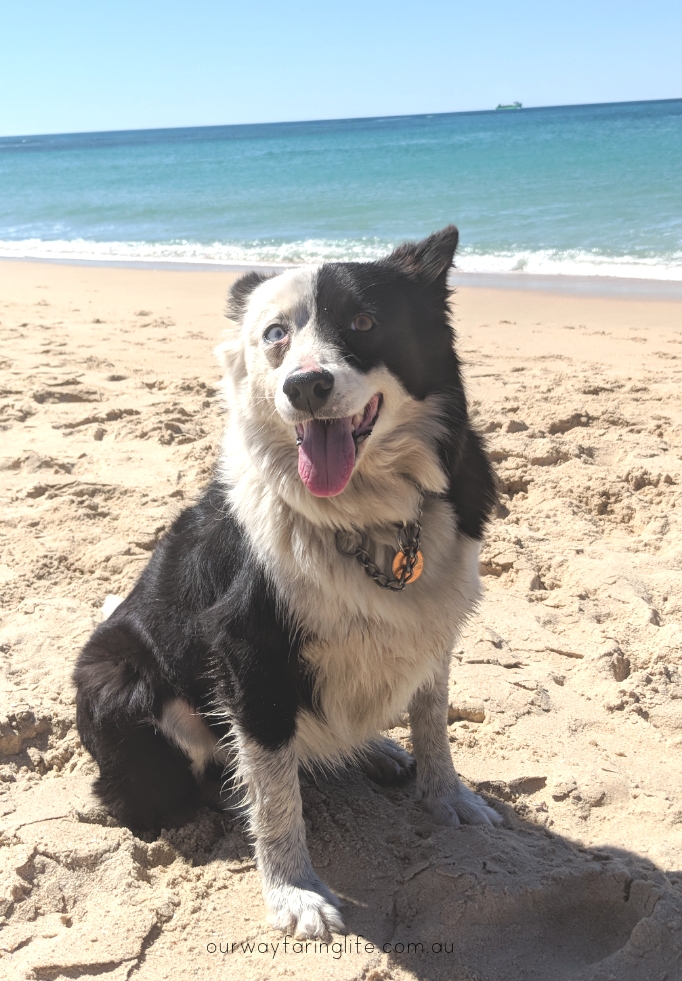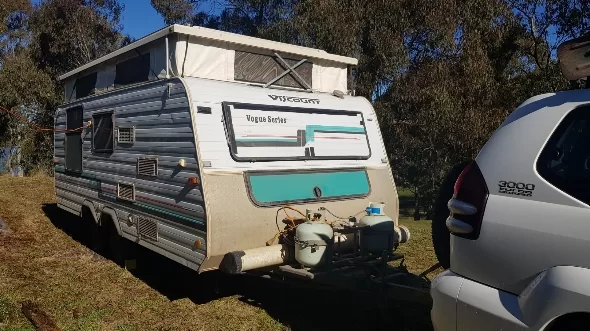Last updated on 16 March, 2021
Travelling or holidaying with your dog can be an absolute joy. Having a dog with good manners, that has some basic training is essential. In this post Dogs Travel Useful Commands we outline the most useful commands for your dog to know before you travel.
It is important of your dog is trained to respond to some useful dog commands so you too can have an enjoyable time travelling with your dog. Useful meaning the type of commands that keep your dog under effective control, help to ensure they are not a threat or nuisance to others, they can be kept safe and make them a pleasure to be around (well mannered).
Daryl and I have made some wonderful memories with Chika as we have travelled Australia in our caravan. Chika is a great travel companion, this is largely because she is a fairly obedient dog.

Why Dog Training is Essential
A dog who is trained and has ongoing regular training sessions is much happier and content this is because a trained dog, through the use of commands (a form of communication), can better understand what is expected from them. In turn it also makes us a lot more pleasant to be around for our dog because we are less likely to become frustrated or angry. Therefore it follows logically that a dog that is trained is a much better companion when travelling or on holidays than one that isn’t.
Training your dog is of course your responsibility and we recommend where possible that your dog is trained to follow as many of the useful commands before your dog travels with you.
Recommended Dogs Travel Useful Commands
Respond to His or Her Name
Obvious, hey? Alarmingly though we have witnessed numerous dogs, especially when distracted, that do not respond to their name. What usually results is everyone nearby learns the dog’s name as it shouted by the owner repeatedly, the dog gains a reputation of being disobedient and everyone witnesses how quickly the owner can loose their temper. Don’t let this be you or your dog.
Sit
Sit is a very basic command. It is useful when travelling, holidaying or camping with your dog because getting your dog to sit is an easy way to get your dog under control and allows your dog to demonstrate some basic manners. We use ‘Sit’ a lot with Chika. She has to sit to be fed. She has to sit to get her lead on for a walk. She has to sit to greet people. She has to sit to be allowed out of the car. Just as a few examples. She has generally learned nothing much happens unless she sits first.
Drop (Lie Down)

Training your dog to Drop (Lie Down) is an important way to help him to control his impulses and this can be very useful in lots of situations when travelling with your dog. Chika is much less responsive to distractions and stimulus if she is the Drop position. The Drop command is the one we use to tell Chika we need her to settle and relax.
Stay
Stay is a very important command. Stay communicates with your dog that she isn’t to wander off and that they are safest to be right where they are. The Stay commands needs lots of practice and is one we continue to practice with Chika regularly especially where there are distractions.
Tip: We often use the Drop and Stay commands together to communicate to Chika ‘there is nothing to see or do here so just relax’. This is often very useful in situations where your dog shouldn’t be the centre of attention and or when you want her to be calm and settled such as when eating at an outdoor café or when relaxing at your campsite.
Recall: Come/Here
The recall command can be taught as Here, Come, his Name and or a Whistle. Good recall is so important and often requires ongoing practice with your dog. A dog with good recall is so much easier to keep under effective control and keep safe. Good recall also means your dog can make use of places such as off leash parks and beaches without you worrying if or when your dog will return to your side. Any dog without good recall should remain on a leash at all times for his safety and to keep your stress levels low. Thankfully, Chika has excellent recall and her most favourite place is any beach she can be off leash. Allowing her time when we can on an off leash beach is pleasant and an easy decision because we know she will come as soon as called.
Tip: Some places such as a windy beach can make it hard for your dog to hear, we taught Chika to come if she sees us standing with our arms held high in a “V” shape.

Leave It (Drop It)
Leave It (Drop It) is also very important. Travelling and being out and about means your dog will potentially be exposed to dangers such as 1080 baits, poisonous plants and fauna and other nasties that could harm or even kill her. Admittedly, Leave It was not a command Chika knew before we starting caravanning around Australia but we wish it was. Chika is being trained that Leave It means don’t touch and move away or if she has something in her mouth she has to drop it.
No
The No command is one that can be used to communicate with your dog that you want him to immediately stop what he is doing or not to follow through with what was going to. There are many times or situations we would use the no command with Chika, to name only a few, such as when she starts stalking a bird to chase it, when she goes to wander off where we cannot see her, when she is eyeing off our lunch. Funniest is when she audibly huffs at us and gives us the look of you’re ruining my life when we tell her no.
There are of course many other commands that your dog could be taught. Regular training sessions with your dog is something that you should continue as you travel especially including distractions, when travelling there are always distractions.
Your dog will feel safer, more content, secure and confident if they trust you are in control and you can communicate clearly with them through the use of some well trained commands. This in turn makes travel with your dog much more enjoyable and pleasant for you too.
I also want to highlight another way that having a dog that is well versed in some basic and useful commands can be useful. When there are opportunities to teach them to take part in new activities as you travel. For us, this was when we bought a kayak in Tasmania and wanted to train Chika to get on and off and behave appropriately while we are out on the water. Honestly all we used was the On command, show her where her spot is (up the front) and give the commands Stay. It took only a few times kayaking for her to learn what was expected of her while we kayak, now she loves it and we love taking her.
We wish you happy and safe travel with your dog.







